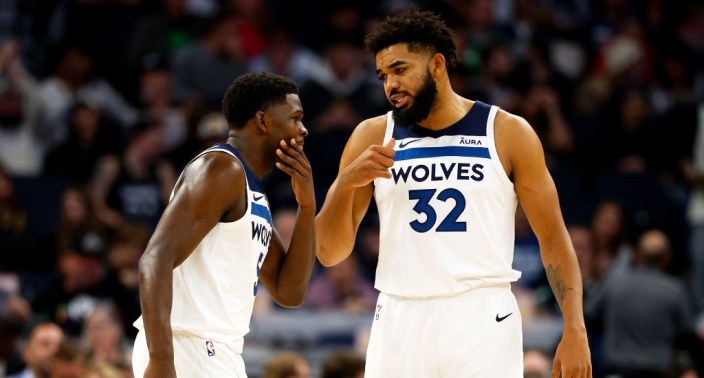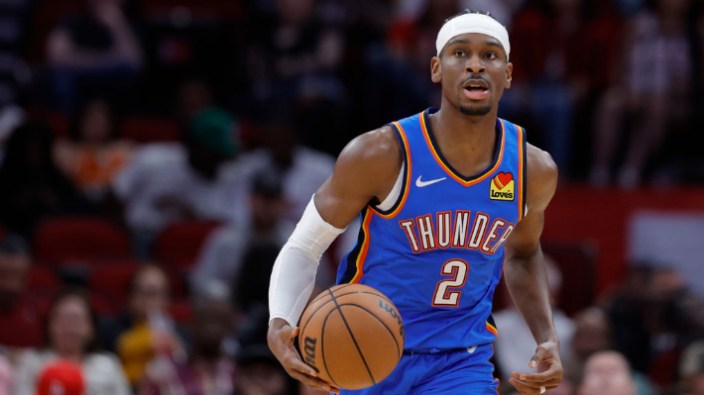
The two best teams in the Western Conference this year look to be the Minnesota Timberwolves and the Oklahoma City Thunder. The No. 1 and No. 3 seeds in the West have yet to lose a game this postseason and are up 2-0 and 1-0 in the conference semis, respectively. But the most impressive thing isn’t just that the Wolves and Thunder are winning, it’s the manner in which they’re doing so.
After dismantling the Suns and sending them into an offseason of soul-searching, the Timberwolves have dominated the defending champs over the first two games in Denver, something no one has done over the last two years. One of those wins came without the DPOY, as Rudy Gobert missed Game 2 for the birth of his first child and the Wolves defense didn’t skip a beat. On Tuesday night, the Thunder got in on the second round fun by routing the Dallas Mavericks in Game 1, led by a similarly suffocating defense that frustrated Luka Doncic and Kyrie Irving into their worst combined scoring night of the playoffs.
There are certainly similarities to how the Wolves and Thunder have built their contenders, with young star guards leading the charge for rosters filled with long, athletic, versatile players. However, they diverge in a few key ways, most notably with Minnesota focusing heavily on an interior presence, while Oklahoma City loaded up on the wing. Regardless of how the rest of the playoffs shake out for both, the biggest lesson from how the two franchises built rapid-rising contenders isn’t necessarily in their specific construction, but in having a clear vision of how they wanted a team to look, play, and even interact off the court.
There is always a little luck involved with landing a young star, either via trade or the draft, but once it’s clear you have one, the real work begins to maximize a window that has presented itself. That’s what happened to the Timberwolves and Thunder as Anthony Edwards and Shai Gilgeous-Alexander began to emerge as two budding faces of the league. What trips up that process for many teams is coming up with a coherent and cohesive plan that has buy-in from top-to-bottom throughout the organization. From the front office to the coaching staff to the stars themselves, there were clearly conversations about what the ideal team would look like, and they have made every single decision with that vision in mind.

For Tim Connelly and the Wolves, they had already had an All-Star in place with Karl-Anthony Towns but needed a backcourt counterpart with the right energy and skillset to help maximize Towns’ abilities and minimize his weaknesses. Edwards, in that regard, was a godsend even beyond his own immense talent. The young guard was happy to step into a vocal leadership role, but in the opposite manner of Jimmy Butler, who tore Towns down in hopes of building him up — Edwards props Towns up with constant praise and affirmation of how good he is. On the floor, Edwards and Towns work in a symbiotic relationship, with Edwards getting more space to attack downhill and Towns getting cleaner looks off the attention Edwards commands. With that pairing in place, the Wolves could go about building a team around them, focusing their efforts on the defensive end while adding complementary skillsets offensively.
They drafted Jaden McDaniels as a hopeful fit between Edwards and Towns on the wing, and took Naz Reid to provide a potential avenue to keeping a big who is a shooting threat on the floor at all times. Those two obviously developed into phenomenal supporting pieces, but the thoughtfulness about skills and fits ensured that if they did get some developmental luck, they’d fill two critical spots on their roster.
From there, they signed Kyle Anderson, a veteran in the mold of the long, versatile defenders they hoped to fill their wing spots with. Then, a day later, they made their biggest move of all, trading their most valuable future assets and some young talent to bring in Rudy Gobert, the then 3-time DPOY. Once Gobert was on board, they tried to evaluate what they’d crafted for the first half of the ’22-23 season, and came to the conclusion they needed more. They shipped out D’Angelo Russell to bring back Mike Conley and Nickeil Alexander-Walker in a three-team trade, opting for more defense, some much-needed veteran steadiness in the backcourt, and a guard who knew how to coax the most out of Gobert.
With all of that in place, they were able to create the culture and identity that now has this team dominating the defending champs. The team feeds off of each other, with Edwards’ energy being infectious, Gobert and McDaniels’ defensive focus spreading to teammates that were otherwise apathetic on that end, and Conley’s calming influence balancing it all out. Every piece they put in place was done so deliberately and with the overall vision in mind, never deviating from the plan just to bring in a big name to win a press conference.

For the Thunder, they acquired Shai Gilgeous-Alexander in the Paul George trade and have since built almost exclusively through the Draft, but have had similar focus and clarity of vision when it comes to the players taken. The Thunder have been one of the best development teams for years under Sam Presti, largely because they’re one of the best teams at evaluating talent and, more importantly, identifying the qualities that allow players to improve.
Work ethic, curiosity, and a willingness to be coached are prerequisites of the Oklahoma City program. Every team talks about wanting players with those attributes, but Presti and the Thunder staff are better than just about anyone at cutting to the core of players to figure out whether they possess those qualities. They focus heavily on players with positional versatility and a strong defensive background who are willing to put in the work to improve offensively. You can have the best development staff in the league, but without players willing to spend the extra hours to hone their craft and make those leaps, it won’t matter.
Lu Dort is maybe their greatest development win, turning from a two-way signee with defensive upside into a cornerstone of the starting lineup, working tirelessly to become not just a competent three-point shooter but a flat-out threat from the three-point line. From there, Jalen Williams and Chet Holmgren came from the same 2022 Draft and have become Gilgeous-Alexander’s co-stars, both bringing two-way impact that’s launched this team into contention this year. Josh Giddey, their top pick in 2021, provides a secondary playmaker next to SGA, while rookie Cason Wallace and Aaron Wiggins (a second rounder from that 2021 Draft) bring depth to the rotation behind him if they want to swap playmaking for shooting, as we saw in Game 1 against Dallas. Jaylin Williams, also from that 2022 Draft, has become a steady backup big for Holmgren that likewise can space the floor offensively.
Their lone rotation players that weren’t drafted in-house are Isaiah Joe and Gordon Hayward. Neither were hot commodities, but each aligned with the team’s culture and filled a need with Joe’s shooting and Hayward’s veteran steadiness.
Everyone is always looking for trends in the NBA, and sometimes there are things to learn about where the game is going from emerging teams. But the real lesson to be learned from the construction of most any championship roster is that you have to have a clear plan and execute it at every level. The first step is to acquire and identify who your best players are, and be honest about who can be your absolute best player and who is a secondary star. From there, you have to craft a vision of what the best team looks like around them both in roster makeup and in play style, with the front office and coaching staff in agreement. Finally, you have to always have that vision in mind when bringing in and sending out players, while being adaptable to changing needs as players either continue to develop or stagnate.
That’s why trying to copy a certain team’s style rarely pans out, because the best teams build their style and roster around the talent they have. What the Thunder and Timberwolves are doing isn’t particularly groundbreaking, but that’s part of what makes their build so remarkable. They have, for the most part, blocked the outside noise and temptations to chase an apparent trend, choosing instead to have internal resolve in what they’re building and how they are doing it.
That’s incredibly difficult to do, because there are always forces trying to push and pull you in different directions. Egos exist from players to coaches to executives to ownership, and can derail a build as quickly as it starts once one party decides they aren’t properly involved or credited. Injuries are the ever-present boogeyman in sports, rendering the best laid plans moot or creating the appearance that a plan isn’t working. Both teams have pushed through those potential pitfalls to give themselves a chance this year.
The Wolves could have decided the Gobert-Towns pairing wouldn’t work after a small sample last year, as Towns missed most of the season. The Thunder could’ve listened to those of us who felt they needed to cash in chips for an established veteran to help them take the next step to contention. Instead, they did what has become an overwrought sports cliche and trusted the process. Most importantly, they trusted their process rather than attempting to duplicate someone elses. And both were led by stars in Edwards and Gilgeous-Alexander who have never once waivered in their belief that the organization is going down the right path — it is much, much easier to execute a long-term vision when your best player isn’t attempting to speed you along, and Edwards and Gilgeous-Alexander have totally bought into the vision as it was presented to them.
Now we’ll see teams try to find the blueprint of what Minnesota and Oklahoma City have done, but most will fall short if all they take away from their success is that long, versatile wing defenders are the answer. That alone won’t get it done — just ask the Raptors. However, the teams that see how the vision came together thanks to true cohesion throughout the organization will give themselves a chance at replicating their success. They’ll just have to find the right stars and tailor their build around them.
